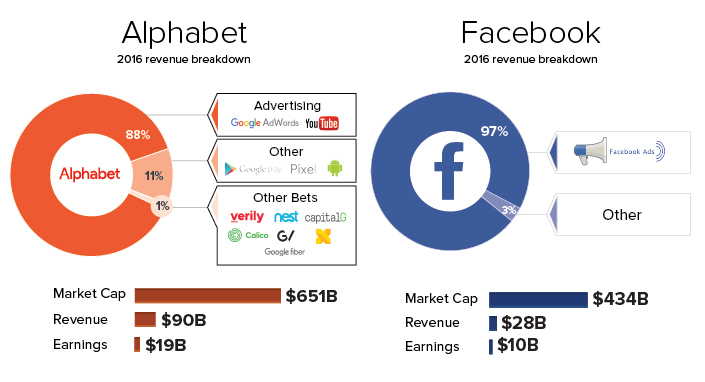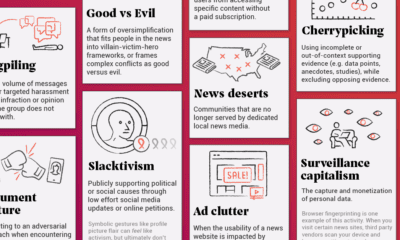Both Alphabet and Facebook have carefully worked at crafting their public images. Most people see these companies as forward-looking tech companies that are shaping our future through high-flying initiatives like Google X or Oculus VR. They put money into big moonshots that could potentially change the world, and their actions are closely followed by people in and outside of the technology sector. But, despite these other initiatives and some diligent messaging, make no mistake – both Alphabet and Facebook are media companies that get their money from one source. Advertising makes up the vast majority of their business, and they’ve both become very good at it.
True Ad Dominance
Earlier this year, we put together a chart that broke down the revenues of the large tech companies:
Facebook earns 97% of its revenue from ads. Meanwhile, Alphabet earns 88% from ads, while getting less than 1% of its revenue from moonshots (at least for now). Alphabet and Facebook are so good at advertising, in fact, that traditional media can’t keep up – and as a result, companies like CBS, 21st Century Fox, and iHeartMedia are now fighting for scraps.
Three is a Crowd
It’s not just Alphabet and Facebook that have unlocked the secret to ad dominance. They were just the fastest to do so. China’s search engine giant, Baidu, is quickly climbing the ranks as well. Even though growth slowed in 2016 due to changes in China’s ad rules, the company will eventually be the third-largest media giant in the world. If Baidu can bump ad revenues by another 20%, it’ll move past Comcast, which owns brands like NBCUniversal and Telemundo. Microsoft is also making its presence felt, debuting in the Top 10 for the first time in 2016. Microsoft’s Bing search network is now in 36 countries, while making up 33% of the U.S. PC search market. On top of that, the company also acquired LinkedIn, which now contributes $1 billion in revenue to the coffers. The sea change is still in process – but in a couple years, there may not be a single traditional media that makes the top five list for global ad revenues. The tech takeover continues. on But fast forward to the end of last week, and SVB was shuttered by regulators after a panic-induced bank run. So, how exactly did this happen? We dig in below.
Road to a Bank Run
SVB and its customers generally thrived during the low interest rate era, but as rates rose, SVB found itself more exposed to risk than a typical bank. Even so, at the end of 2022, the bank’s balance sheet showed no cause for alarm.
As well, the bank was viewed positively in a number of places. Most Wall Street analyst ratings were overwhelmingly positive on the bank’s stock, and Forbes had just added the bank to its Financial All-Stars list. Outward signs of trouble emerged on Wednesday, March 8th, when SVB surprised investors with news that the bank needed to raise more than $2 billion to shore up its balance sheet. The reaction from prominent venture capitalists was not positive, with Coatue Management, Union Square Ventures, and Peter Thiel’s Founders Fund moving to limit exposure to the 40-year-old bank. The influence of these firms is believed to have added fuel to the fire, and a bank run ensued. Also influencing decision making was the fact that SVB had the highest percentage of uninsured domestic deposits of all big banks. These totaled nearly $152 billion, or about 97% of all deposits. By the end of the day, customers had tried to withdraw $42 billion in deposits.
What Triggered the SVB Collapse?
While the collapse of SVB took place over the course of 44 hours, its roots trace back to the early pandemic years. In 2021, U.S. venture capital-backed companies raised a record $330 billion—double the amount seen in 2020. At the time, interest rates were at rock-bottom levels to help buoy the economy. Matt Levine sums up the situation well: “When interest rates are low everywhere, a dollar in 20 years is about as good as a dollar today, so a startup whose business model is “we will lose money for a decade building artificial intelligence, and then rake in lots of money in the far future” sounds pretty good. When interest rates are higher, a dollar today is better than a dollar tomorrow, so investors want cash flows. When interest rates were low for a long time, and suddenly become high, all the money that was rushing to your customers is suddenly cut off.” Source: Pitchbook Why is this important? During this time, SVB received billions of dollars from these venture-backed clients. In one year alone, their deposits increased 100%. They took these funds and invested them in longer-term bonds. As a result, this created a dangerous trap as the company expected rates would remain low. During this time, SVB invested in bonds at the top of the market. As interest rates rose higher and bond prices declined, SVB started taking major losses on their long-term bond holdings.
Losses Fueling a Liquidity Crunch
When SVB reported its fourth quarter results in early 2023, Moody’s Investor Service, a credit rating agency took notice. In early March, it said that SVB was at high risk for a downgrade due to its significant unrealized losses. In response, SVB looked to sell $2 billion of its investments at a loss to help boost liquidity for its struggling balance sheet. Soon, more hedge funds and venture investors realized SVB could be on thin ice. Depositors withdrew funds in droves, spurring a liquidity squeeze and prompting California regulators and the FDIC to step in and shut down the bank.
What Happens Now?
While much of SVB’s activity was focused on the tech sector, the bank’s shocking collapse has rattled a financial sector that is already on edge.
The four biggest U.S. banks lost a combined $52 billion the day before the SVB collapse. On Friday, other banking stocks saw double-digit drops, including Signature Bank (-23%), First Republic (-15%), and Silvergate Capital (-11%).
Source: Morningstar Direct. *Represents March 9 data, trading halted on March 10.
When the dust settles, it’s hard to predict the ripple effects that will emerge from this dramatic event. For investors, the Secretary of the Treasury Janet Yellen announced confidence in the banking system remaining resilient, noting that regulators have the proper tools in response to the issue.
But others have seen trouble brewing as far back as 2020 (or earlier) when commercial banking assets were skyrocketing and banks were buying bonds when rates were low.














